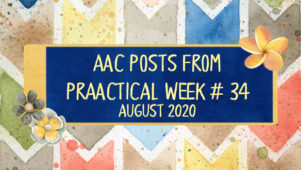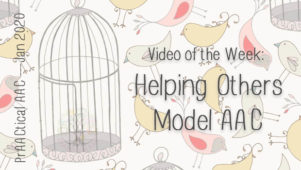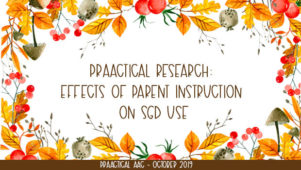Building AAC Facilitation Skills with Tabi Jones-Wohleber: MASTER PAL Training, Module 9 (Presume Potential)
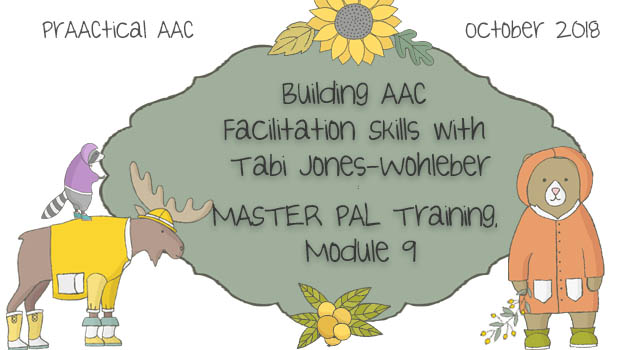
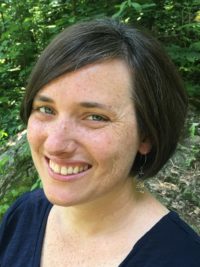 We continue our AAC partner training series, authored by SLP Tabi Jones-Wohleber, with a 60-minute session on presuming potential. In addition to her work with the AT Team for Frederick County Public Schools in Maryland, Tabi serves young children and their families at West Virginia Birth to Three programs.
We continue our AAC partner training series, authored by SLP Tabi Jones-Wohleber, with a 60-minute session on presuming potential. In addition to her work with the AT Team for Frederick County Public Schools in Maryland, Tabi serves young children and their families at West Virginia Birth to Three programs.
You can see the first 8 modules here.
:::::::::::::::::::::::::::::::::::::::::::::::::::::::::::::::::::::::::::::::::::::::::::::::::::::
Model as a MASTER PAL
Module 9: Presume Potential
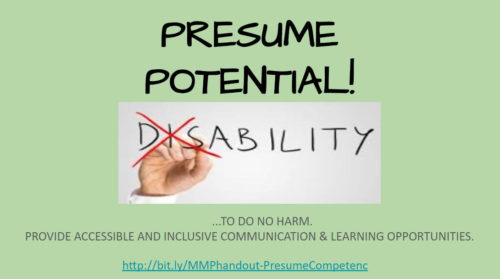
Presuming potential is a belief system that influences our words and actions both consciously and unconsciously. As such it cannot be overstated that our words and actions shape the nature and trajectory of opportunities for learning, communicating and engaging for those with whom we interact who use AAC. This module showcases a parent perspective, and utilizes many video examples to invite participants into an honest and reflective conversation on the need to shed assumptions about where an individual’s learning will “max out”. It emphasizes the need presume potential in order to provide accessible opportunities for individuals to contribute meaningfully to the communities in which they live and learn.
For this session, you will need:
Warm-up Discussion
| Thinking Prompt | Making Connections / Talking Points |
| Before sharing the definition on Slide 8, discuss how participants understand this buzz-phrase “presume competence.” | This conversation provides the facilitator useful insight into where participants are on this issue. The important thing to understand is that presuming potential starts with a belief system that shapes the way one engages with and instruct students. Belief systems can be shaped but they can’t be mandated. This section includes several videos and talking points to spark discussion around presumed potential, but ultimately each individual has to come to this belief system on their own. Those that open-up and expose their passion or vulnerability may express some of the following sentiments:
Show the definition. Attend especially to the bolded statement “provide opportunities by creating accessible & inclusive spaces”. The importance of this statement is in the recognition that students can’t showcase their potential when opportunities to rise to challenges aren’t presented. It is important to meet students where they are BUT to also assume they will ALWAYS progress beyond that place, and provide the necessary opportunity and motivation to do so. Put another way, presuming competence is assuming the individual will be a lifelong learner, and not assuming to have knowledge or understanding of where his/her learning will stop, regardless of the place you start with him/her. |
The Discourse
| Topics Addressed | Slide(s) | Talking Points / Examples |
| Title Slides | 1-2 | N/A |
| Communication Review | 3-7 | Review of Model as a MASTER PAL and AAC to ensure all participants are on the same page. |
| Definition | 8-10 | Explained on Slides.
See chart above for Warm-up Discussion. Slide 9 Video: An introduction to Presumed Competence with Susan Norwell |
| YouTube Video
#ProjectListen: Looking to Listen (5:18) |
11 | YouTube Link: This is a bit of a tear-jerker. It is the story of a child with Rett Syndrome finding her voice. Her voice allowed her parents to understand and unlock the potential inside her.
Give participants the opportunity to reflect on the video. Do they know a student like this? Does it make them think of a particular student differently? |
| Parent Defined Presumed Competence | 12-15 | Introduce these slides by referencing the link at the bottom and informing them that the following statements were shared by a parent. Tell them that you will read each statement, then pause. Invite them to share aloud their thoughts, experiences, aha! or other reflections related to each statement. Offer your own reflections and interpretations on some statements as well. The pause between statements (at least 5 seconds) compels thoughtfulness, even if no one speaks up. Note aloud the head nods to affirm consensus. If no one speaks up, move on to the next statement..no judgment; this topic requires thoughtfulness. Provide an opportunity for discussion, in general, or of specific points, at the end.
Slide 12– Pictures of “alternative means to demonstrate learning”…visual, tactile & kinesthetic. Though these images are of younger students, the same principles apply to secondary students. Specific resources for age-appropriate content beyond pre-school include:
|
| Carly Fleishmann Videos | 16 | Feel free to select your own video segments. The following are suggested.
Video 1: Up to about 5:50 This video provides a starts to a great narrative of how communication and presumed potential can change everything for a child and those in the child’s environment. Video 2: Up to about 2:00 There are many videos of Carly’s interviews. This is just one. It should be noted that questions and comments may be pre-recorded, but they are novel and self-generated. Some videos do show her composing messages “on the fly”. She demonstrates wit, humor, & insight and does so with well-formed language. |
| Self-Fulfilling Prophecy | 17 | Explained on the slide (animated slide). |
| Biases Shape our Behavior | 18 | This is an animated slide. Red statements come in one at a time.
Presumed potential is a belief system that outwardly manifests itself in our behaviors, subtle and overt. Consider each statement/question and how it contributes to or detracts from presumed potential. |
| Ability Positive Language | 19 | The language we use speaks volumes about our beliefs and biases. Consider how each of the different examples feels to a child. Consider the message conveyed to a parent of a child with a disability in each of the examples. Remember, we must not set an arbitrary ceiling on a child’s potential. There are no crystal balls in AAC. And self-fulfilling prophecies can help or harm. |
| Final Thoughts | 20-21 | Quote from PrAACtical AAC.
Do no Harm! |
| Let’s Re-Cap | 22 |
|
Supplemental Handouts
- Hussman Institute – Presume Competence
- Tobii Dynavox, Learning Pathways – Article-at-a-Glance, Least Dangerous Assumption
Video Links
- The Parent’s Journey from Presuming Competence to Supporting Competence
- How my mind came back to life…and no one knew
Interactive Activities/Discussions
- See slides 11-15
- Video discussion on slides 10, 15
Extension Resources
- Assistiveware Blog
- Literature/Books
- Out of My Mind by Sharon Draper
- Ghost Boy by Martin Pistorius
- The Diving Bell and the Butterfly by Jean-Dominique Bauby
- North West Augmentative Communication Society Blog – Got Precepts
- NPR Series – Abused and Betrayed
- Speech Science Blog – Ready for Some Myth-Busting? A Word on Cognitive Referencing

Filed under: Featured Posts, PrAACtical Thinking
Tagged With: AAC partner training, presume potential, Tabi Jones-Wohleber
This post was written by Carole Zangari

